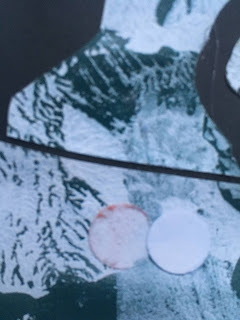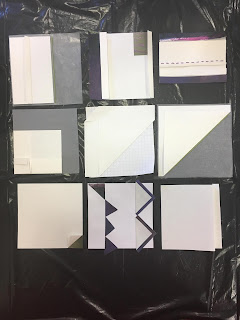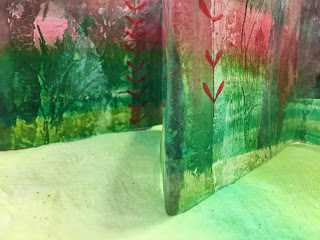Following on from my last entry in August and my beginning of chapter 12 several decision have since been made.
Firstly I've decided to work in all white / cream fabrics and threads to enable me to achieve the translucency, frothiness and some of the magic I feel when I come across cow parsley in the hedgerows.
Secondly I've made a slight change to the samples chosen for this piece and have decided upon samples 2a, 3a and 3c [photos of these are posted in my previous entry for ch 12].
Thirdly we are asked to consider whether areas of the design would be worked on the same level or raised from the surface. I found that as I worked each piece took on a life of it's own and I'll explain this as I go.
I'm reposting an image of my paper design to start with, we are to work from this and not from our original photos.
As you can see the different parts are numbered
1 = sample 3c
2= sample 3a
3= sample 2a
4= the surrounding areas
I'll talk about each sample in turn and use photos to demonstrate the inspiration from paper to stitching.
I have used a background of quilted fabric as a base and this is revealed between each sample. [see sample 10 in chapter 5]. This is worked on Chinese silk over wool backing with free machine embroidered Vermicelli stitching, the sample was then washed at 60 degrees to shrink the wool and produce a quilted effect.
Sample 3c paper design detail
Sample 3c stitched sample
I have used white Stranded Cotton, Cotton Perle and worked Detached Chain and Fly Stitches in a directional fashion plus French Knots in a linen thread topped by more Detached Chain in ivory and white ribbons. Painted Hollyhock seeds have been threaded through tunnels of white Chiffon and arranged to represent the 'florets' on the paper design and couch stitched into place. I've used a polyester wadding to raise the surface of the 'florets' and then secured it with slip stitches to the background fabric.
Sample 3a paper design detail:
Sample 3a stitched.
Several bundles of florets using Hollyhock seeds [painted white] have been trapped between 2 layers of white chiffon with white thread wrapped around the necks of the seed pockets. As I worked I was delighted to discover that they developed into little puffballs which settled into a naturally shaped soft round ball which just needed stitching into place!
Sample 2a Paper detail:
2a Stitched sample.
I worked on an ivory silk fabric and stitched free machine embroidered discs worked in an embroidery hoop for support. After which I used polyester machine thread to gather the fabric around the necks of the discs which in turn created beautifully formed pleats which reflected the shapes within the American Smocking and the Fly Stitching in the surround
Sample 4 top left corner paper design detail
Stitched sample using the American smocking technique on Chinese silk with 2 strands of white Stranded Cotton. The smocking is distorted by working one row on the right side and alternates on the wrong side and then manipulated to fit the space. I was also aware of working in a directional fashion to compliment the design. I feel the ripples of the monoprinting is reflected in the smocking effectively although sometimes the needle and thread lead the way!
Sample 4 bottom left paper design detail:
Stitched sample on shot silk with a polyester sewing thread using a larger scaled American smocking again distorted and manipulated. This took on a beautiful curved effect giving this corner a wonderful feeling of movement which really reflected the shapes of the monoprinted design. There is a Fly stitch edge which I'll deal with separately
Sample 4 top right and corner paper design detail:
Stitched sample worked on Chinese silk with Polyester thread with a Fly stitched edging worked in a thick silk yarn
Sample 4 bottom right paper design detail
Stitched sample a finer American Smocking worked on Chinese silk with fine polyester thread. [the quilted background is visible here too.
Throughout the work on this piece Fly and Feather Stitches are represented on the monoprinted papers and in this example which is a detail of the right hand side of the paper design I've used both American Smocking and Fly / Feather stitches
Fly and feather stitches worked in layers and in between using a combination of silk, stranded cotton and linen threads. I am delighted with the textures achieved here especially as they merge with the American Smocking.
Fly stitch left edge paper design detail:
Lots of wonderful opportunities for creating texture with Fly Stitch here using a thick and finer silk yarns in layers and in a directional fashion to reflect the shape of the design:
Bottom section of paper design showing monoprinted marks:
Lots of exciting opportunities to work a flowing Fly Stitch in linen threads, sweeping between the samples
Paper design detail top of design:
Fly stitch at top of resolved sample.
And last but not least! My resolved sample.
I've been thinking about the edges and have decided that whilst some will be softly turned under where it seems fit the others will be left to spread where the stitching has created beautiful undulating folds and ripples to add to the sense of rhythm and movement of the finished piece.
To finish this resolved sample will be placed on a length of fabric stretched over a support and placed in a box frame with space around to compliment the beauty of the edges
I'm delighted with the outcome of this piece of work.
Many hours of stitching involved but I love the translucency, the rhythm and the delicacy of the floret samples. I can remember American Smocking being in fashion in the 1960s and 70s when I was a teenager so it was a thrill to put my own take on them!!



























































